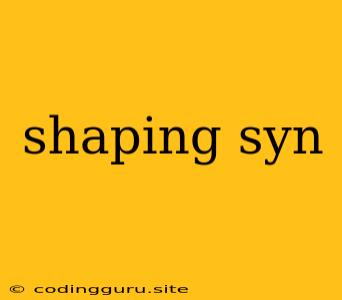Shaping Your Synths: A Guide to Creating Unique Sounds
Shaping synths is an essential aspect of electronic music production. It's the process of manipulating and modifying the sound of a synthesizer to create unique and interesting textures, melodies, and rhythms. This can be achieved through a variety of techniques, from tweaking basic parameters to employing complex modulation and effects.
But how do you shape your synths to make them truly stand out?
This guide will delve into the world of synth shaping, exploring different techniques and offering practical advice to help you craft your own signature sound.
Understanding the Basics:
Before we dive into advanced techniques, it's crucial to understand the fundamental building blocks of synth shaping.
- Oscillators: These are the sound generators of a synthesizer, producing the initial waveform. Experiment with different waveforms like sine, sawtooth, square, and triangle to explore a wide range of timbral possibilities.
- Filters: Filters shape the frequency spectrum of your sound, allowing you to sculpt the tone and character. Low-pass filters attenuate high frequencies, producing warm, rounded tones, while high-pass filters emphasize the higher frequencies, creating bright and piercing sounds. Band-pass filters allow a specific frequency range to pass through, creating resonant and unique effects.
- Envelopes: Envelopes determine how the amplitude (volume) of your sound changes over time. Attack, decay, sustain, and release are the four main stages of an envelope, and adjusting them can dramatically alter the dynamics of your synth sound.
- LFOs (Low-Frequency Oscillators): LFOs are used to create subtle or dramatic modulation effects. They can be applied to various parameters like pitch, filter cutoff, or amplitude to add movement and interest to your sounds.
Shaping Techniques:
1. Experiment with Filters: Filters are your primary tools for shaping the tonal character of your synths.
Tips:
- Sweep the cutoff frequency: Use an LFO or automation to gradually change the cutoff frequency of your filter, creating a dynamic, evolving sound.
- Use filter envelopes: Create interesting sonic textures by modulating filter cutoff with an envelope.
- Experiment with filter resonance: Increase resonance to create a prominent peak in the filter response, resulting in a more pronounced and sometimes even distorted sound.
2. Explore Modulation: Modulation adds movement and depth to your sounds.
Tips:
- Modulate pitch with LFOs: Create vibrato, tremolo, or other pitch-based effects by modulating pitch using an LFO.
- Use envelopes for filter cutoff: Create dynamic filter sweeps and sonic transformations by modulating filter cutoff with envelopes.
- Experiment with modulation destinations: Explore other parameters like amplitude, pan, or even delay time for unique modulation effects.
3. Enhance with Effects: Effects can add color, dimension, and even distortion to your synth sounds.
Tips:
- Use reverb and delay: Create spaciousness and depth by adding reverb and delay.
- Experiment with chorus and flanger: Enhance your sounds with subtle or pronounced chorus and flanger effects to thicken and widen the sound.
- Add distortion and overdrive: Push your sounds beyond their limits and introduce a gritty, distorted edge with distortion and overdrive effects.
4. Embrace Automation: Automation allows you to control how parameters change over time, creating dynamic and evolving synth sounds.
Tips:
- Automate filter cutoff: Create sweeping, rhythmic, or subtle filter movements by automating filter cutoff.
- Automate pitch: Introduce melodic or rhythmic variations to your sounds by automating pitch.
- Automate LFOs: Change the rate, depth, or waveform of LFOs over time to create unique and complex modulation patterns.
5. Layer Your Sounds: Layering multiple synth sounds can create rich, complex textures and sonic landscapes.
Tips:
- Combine different synth types: Layer a warm pad with a sharp, piercing lead synth for a contrasting and dynamic effect.
- Use different waveforms: Layer a sine wave with a sawtooth wave to create a rich, full sound.
- Experiment with panning and stereo imaging: Create width and depth by panning different synth layers across the stereo field.
Example Synth Shaping Workflow:
1. Choose a Synth: Select a synth with features that align with your desired sound. 2. Select a Waveform: Begin with a basic waveform like a sine wave or a sawtooth. 3. Shape with Filters: Apply a low-pass filter and sweep the cutoff frequency to create a warm and evolving sound. 4. Add Modulation: Modulate the filter cutoff with an LFO to introduce movement and depth. 5. Enhance with Effects: Add a touch of reverb and delay to create a more spacious sound. 6. Experiment with Automation: Automate the filter cutoff to create a dynamic and evolving sound.
Conclusion:
Shaping synths is a creative journey of exploration, experimentation, and sonic discovery. By understanding the fundamentals and employing various techniques, you can unlock endless sonic possibilities and craft unique and unforgettable synth sounds.
Remember, there are no limits to your creativity. Be bold, experiment, and never stop pushing the boundaries of your synth shaping abilities!
